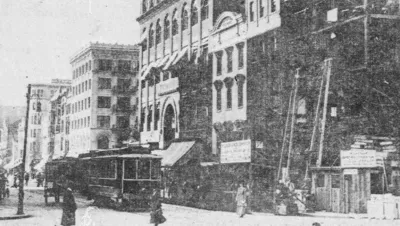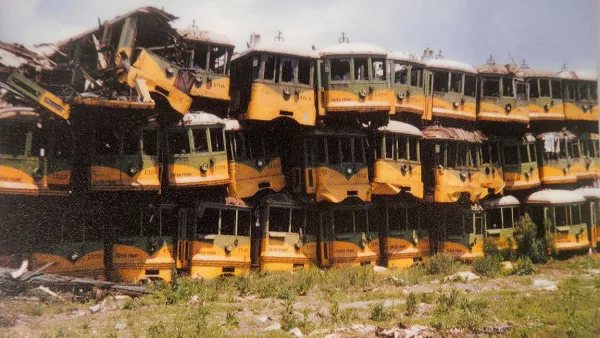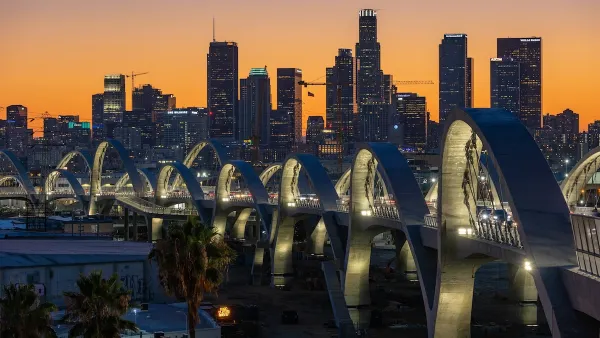Yes, there was a conspiracy led by General Motors to replace streetcars with their buses in the 1930s. But streetcars were dying well before then, due to competition with the automobile and other reasons apart from nefarious corporate collusions.

Joseph Stromberg of Vox provides yet another reminder that the convenient scapegoat for the death of public transit in the United States can not be laid at the doorsteps of General Motors. [If you haven't read Stephen Smith's 2010 article in Market Urbanism about the conspiracy and how it is misinterpreted by some in the planning profession today, it's summarized and linked here.]
"There's this widespread conspiracy theory that the streetcars were bought up by a company National City Lines, which was effectively controlled by GM, so that they could be torn up and converted into bus lines," says Peter Norton, a historian at the University of Virginia and author of Fighting Traffic: The Dawn of the Motor Age in the American City.
But that's not actually the full story, he says. "By the time National City Lines was buying up these streetcar companies, they were already in bankruptcy."
For the record, there was a conspiracy according to the 1949 U.S. Supreme Court's ruling in UNITED STATES v. NATIONAL CITY LINES, Inc., et al. But can General Motors, as well as Firestone Tire, Standard Oil of California, Phillips Petroleum, and Mack Trucks (the other companies found guilty in the lawsuit) be blamed for tearing up almost 17,000 miles of streetcar tracks?
"The real reasons for the streetcar's demise are much less nefarious than a GM-driven conspiracy — they include gridlock and city rules that kept fares artificially low — but they're fascinating in their own right, and if you're a transit fan, they're even more frustrating," writes Stromberg. I would add that if you're a transportation planner and/or advocate, it's even more reason to get the story straight as those problems apply to some degree today, as posted here and here.
The real problem was that once cars appeared on the road, they could drive on streetcar tracks — and the streetcars could no longer operate efficiently. "Once just 10 percent or so of people were driving, the tracks were so crowded that [the streetcars] weren't making their schedules," Norton says.
While it's true that National City continued ripping up lines and replacing them with buses — and that, long-term, GM benefited from the decline of mass transit — it's very hard to argue that National City killed the streetcar on its own. Streetcar systems went bankrupt and were dismantled in virtually every metro area in the United States, and National City was only involved in about 10 percent of cases.
"The Los Angeles Streetcar system developed into the largest trolley system in the world by the 1920’s," according to Los Angeles Streetcar, Inc. Stromberg cites Cecilia Rasmussen at the Los Angeles Times, who wrote in 2003, "With 160,000 cars cramming onto Los Angeles streets in the 1920s, mass-transit riders complained of massive traffic jams and hour long delays." Rasmussen also describes the 1988 animated comedy that become associated with the plot:
"Who Framed Roger Rabbit" [YouTube] became to traffic planning what "Chinatown" was to Los Angeles water politics -- but with more laughs.
Although it's tempting to believe that evil forces must have been to blame, most historians agree that GM and the other mega-companies only helped to speed the end of the railway, which already was deep into red ink. There were mixed court verdicts, with fines levied that were considered a drop in the bucket.
CityLab's Eric Jaffe in 2013 provided an equally good recount of what caused the death of the American streetcar, including the 1974 testimony of former antitrust attorney for the United States Senate, Bradford C. Snell, which "introduced the scandal theory to a wider public."
Hat tip to Angie Schmitt of Streetsblog USA.
FULL STORY: The real story behind the demise of America's once-mighty streetcars

Analysis: Cybertruck Fatality Rate Far Exceeds That of Ford Pinto
The Tesla Cybertruck was recalled seven times last year.

National Parks Layoffs Will Cause Communities to Lose Billions
Thousands of essential park workers were laid off this week, just before the busy spring break season.

Retro-silient?: America’s First “Eco-burb,” The Woodlands Turns 50
A master-planned community north of Houston offers lessons on green infrastructure and resilient design, but falls short of its founder’s lofty affordability and walkability goals.

Test News Post 1
This is a summary

Analysis: Cybertruck Fatality Rate Far Exceeds That of Ford Pinto
The Tesla Cybertruck was recalled seven times last year.

Test News Headline 46
Test for the image on the front page.
Urban Design for Planners 1: Software Tools
This six-course series explores essential urban design concepts using open source software and equips planners with the tools they need to participate fully in the urban design process.
Planning for Universal Design
Learn the tools for implementing Universal Design in planning regulations.
EMC Planning Group, Inc.
Planetizen
Planetizen
Mpact (formerly Rail~Volution)
Great Falls Development Authority, Inc.
HUDs Office of Policy Development and Research
NYU Wagner Graduate School of Public Service




























